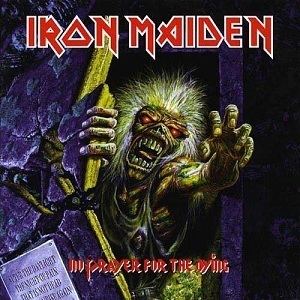Released 1 October 1990 Length 43:42 Release date 1 October 1990 Label Epic/Sony Records | Recorded June – September 1990 | |
 | ||
No Prayer for the Dying(1990) Similar Iron Maiden albums, Heavy metal albums | ||
No Prayer for the Dying is the eighth studio album by English heavy metal band Iron Maiden. It marks their first line-up change since 1982; guitarist Adrian Smith left the band during the pre-production phase, unhappy with the musical direction it was taking, and only having contributed to one song, "Hooks in You". Smith was replaced by Janick Gers, who had previously worked with singer Bruce Dickinson on his first solo-album, Tattooed Millionaire, and had also worked with Ian Gillan, former Marillion singer Fish, and new wave of British heavy metal band, White Spirit.
Contents
- 8 no prayer for the dying 1990 iron maiden full album
- Background
- Album cover
- Critical reception
- Personnel
- Songs
- References
Although it received generally mixed to negative reviews, the album peaked at No. 2 in the UK Albums Chart and contains the band's only UK Singles Chart No. 1, "Bring Your Daughter... to the Slaughter".
8 no prayer for the dying 1990 iron maiden full album
Background
The album departed from the keyboard- and synthesiser-saturated progressive rock direction of the band's two previous studio outings (1986's Somewhere in Time and 1988's Seventh Son of a Seventh Son) in favour of a more "stripped down," straightforward style, reminiscent of the band's earlier material, which ushered in a change of vocal style for Bruce Dickinson from the operatic sound of the 1980s to a raspier way of singing. The idea to make a more "street level" release also inspired the band to record in a barn on bassist Steve Harris's property in Essex, using the Rolling Stones Mobile Studio. This means it is the first Iron Maiden album to be recorded in their home country since 1982's The Number of the Beast. Dickinson states that this idea was a mistake, commenting that "It was shit! It was a shit-sounding record, and I wished we hadn't done it that way. At the time, I was as guilty as anyone else in going, 'Oh great! Look, we're all covered in straw! What a larf!'"
The album also departed from literary and historical lyrical themes in favour of more political content, with songs focusing on religious exploitation (such as in the record's first single, "Holy Smoke") and social concerns ("Public Enema Number One"). No Prayer for the Dying is the only Iron Maiden studio album to date without a song exceeding six minutes in length and the second one to contain profanity in the lyrics, the debut album being the first to do so. It was also the band's first release with Epic Records in the US, after the band left Capitol Records, but was sold through EMI for all territories outside the US. Despite charting well in most countries, particularly in the UK where it debuted at No. 2, it would be the band's last album to receive gold certification in the US.
No Prayer for the Dying includes the hit song "Bring Your Daughter... to the Slaughter", which, in spite of a ban by the BBC, remains Iron Maiden's only UK No. 1 single to date. A tongue-in-cheek song written by Dickinson and originally recorded with his solo band for the A Nightmare on Elm Street 5: The Dream Child film soundtrack, Harris decided that the song would be "great for Maiden" and had the band re-record it.
Following Dickinson's departure from Iron Maiden in 1993, songs from No Prayer for the Dying have been largely ignored at live performances. "Bring Your Daughter... to the Slaughter" was the only song played on a post-1993 setlist, appearing on the band's 2003 summer tour.
No Prayer on the Road was the tour in support of the album.
Album cover
No Prayer for the Dying does not follow the continuity of previous album covers, as Eddie no longer exhibits either his lobotomy or cyborg enhancements.
Two versions of the cover exist. The original 1990 version has Eddie bursting from his grave and grabbing a gravedigger by the neck. As the band's manager, Rod Smallwood, disliked the figure, he asked artist Derek Riggs to remove him from the cover for the 1998 re-release, although the original artwork is used on the disc itself. Additionally an inscription was added to the plaque on the tomb, which Riggs had initially left blank to allow the band to add their own words, and reads "After the Daylight, The Night of Pain, That is not Dead, Which Can Rise Again." The picture disc LP shows Eddie firing a weapon made of four machine guns (a reference to the album's opening track, "Tailgunner"). It has the original cover on side two.
Critical reception
The album received generally mixed to negative reviews, with AllMusic commenting that "the songwriting wasn't up to snuff when compared to such classics as Killers or Number of the Beast" and "as a whole doesn't measure up to the hits." Sputnikmusic were equally negative, stating that "No Prayer for the Dying is a plain, listless record that never really gets itself going."
Personnel
Production list acquired from AllMusic and from the album liner notes.
Songs
1Tailgunner4:15
2Holy Smoke3:50
3No Prayer For The Dying4:23
